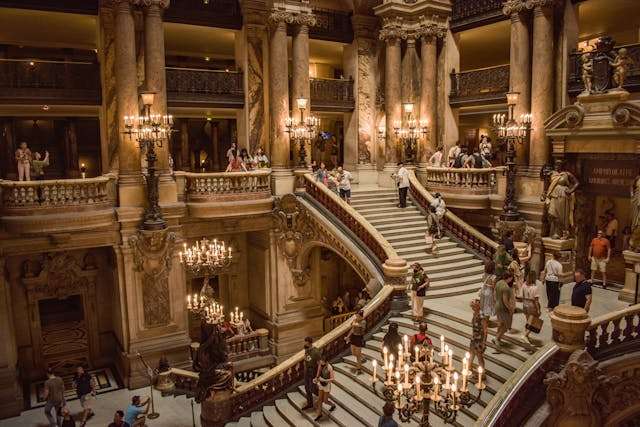| Opera Garnier Paris National Opera House |
The Opera Garnier, also known as the Palais Garnier, is one of Paris’s most stunning landmarks—a true masterpiece of architecture, art, and culture. Standing proudly in the 9th arrondissement, it’s more than just an opera house, it’s a living symbol of 19th-century French elegance and artistic ambition.
History of the Opera Garnier Paris National Opera House
The Palais Garnier also known as Opéra Garnier in French is a 1,979-seat opera house at the Place de l’Opéra in the 9th arrondissement of Paris, France. It was built for the Paris Opera from 1861 to 1875 at the behest of Emperor Napoleon III. Napoleon III (Charles Louis Napoléon Bonaparte; 20 April 1808 – 9 January 1873) was the first President of France (as Louis-Napoléon Bonaparte) from 1848 to 1852 and the Emperor of the French from 1852 to 1870. A nephew of Napoleon I, he was the last monarch to rule over France. Elected to the presidency of the Second Republic in 1848, he seized power by force in 1851, when he could not constitutionally be reelected; he later proclaimed himself Emperor of the French.
The Vision of Napoleon III for Paris National Opera House
In the 1860s, Emperor Napoleon III dreamed of creating a new opera house that would reflect the power and prestige of his reign. It was meant to be part of the grand reconstruction of Paris led by Baron Haussmann, a vision of modernization and magnificence.
The Architect: Charles Garnier’s Genius
The task of bringing this vision to life fell to Charles Garnier, a young and relatively unknown architect. His design won a national competition, and the result was nothing short of spectacular. Garnier blended Beaux-Arts architecture with Baroque and Renaissance elements, creating a building that dazzles inside and out.
The Grand Opening in 1875 of Paris National Opera House
After 14 years of construction and countless challenges—including the discovery of an underground lake, the Opera Garnier officially opened in 1875. Since then, it has hosted countless operas, ballets, and high-society galas.
- Construction started: August 1861
- Opened: January 5, 1875
- Architect: Charles Garnier
- Capacity: 1,979
- Architectural styles: Beaux-Arts architecture, Baroque Revival architecture, Second Empire
- Function: Opera House – The theatre has been a monument historique since 1923
- Site : https://www.operadeparis.fr/en
Initially referred to as le nouvel Opéra de Paris (the new Paris Opera), it soon became known as the Palais Garnier, in acknowledgment of its extraordinary opulence and the architect Charles Garnier’s plans and designs, which are representative of the Napoleon III style. It was the primary theatre of the Paris Opera and its associated Paris Opera Ballet until 1989, when a new opera house, the Opéra Bastille, opened at the Place de la Bastille. The company now uses the Palais Garnier mainly for ballet.
The Grand Staircase – A Symbol of Elegance
The Design and Structure
The Grand Staircase (Le Grand Escalier) is perhaps the most photographed spot in the Opera Garnier. Built from white marble with balustrades of green and red marble, it leads to various floors of the theater in the most dramatic fashion.
The Role in Parisian Society
In the 19th century, attending the opera wasn’t just about the show, it was about being seen. The staircase became the ultimate stage for Paris’s elite to display their wealth.
Architectural Marvel of Garnier Paris National Opera House
The Palais Garnier inspired many other buildings over the following years.
- Teatro Massimo Bellini built from 1870 to 1890 in Catania, Sicily
- The Amazon Theatre in Manaus (Brazil) built from 1884 to 1896. The overview is very similar, though the decoration is simpler
- The Thomas Jefferson Building, built from 1890 to 1897, of the Library of Congress in Washington, D.C. is modelled after the Palais Garnier, most notably the facade and Great Hall
- The Opéra-Comique’s Salle Favart, which opened in 1898, is an adaptation of Garnier’s design on a smaller scale to fit a restricted site.
- Several buildings in Poland were based on the design of the Palais Garnier. These include the Juliusz Słowacki Theatre in Kraków, built during 1893, and also the Warsaw Philharmonic edifice in Warsaw, built between 1900 and 1901.
- The Hanoi Opera House in Vietnam was built 1901–1911 during French Indochina colonial period based upon Palais Garnier. It is considered a representative French colonial architectural monument in Indochina.
- The Theatro Municipal do Rio de Janeiro (1905–1909) was also modelled after Palais Garnier, particularly the Great Hall and stairs.
- The Legends Hotel Chennai in India is inspired by the Palais Garnier, especially the Facade and statues.
- The Façade of the Rialto Theatre, a former movie palace built in 1923–1924 and located in Montreal, Quebec, Canada, was designed after Palais Garnier.
The Beaux-Arts Style Explained
The Opera Garnier is one of the finest examples of Beaux-Arts architecture, a style that celebrates ornamentation, symmetry, and grandeur. Think marble staircases, gilded ceilings, and detailed sculptures that make your jaw drop.
Exterior Grandeur and Details
From the outside, the building commands attention with its golden statues, carved columns, and majestic dome. The façade is a masterpiece featuring allegorical figures representing music, poetry, and dance.
The Interior: A Symphony of Luxury
Step inside, and it’s like entering a royal palace. Every corner bursts with detail mosaics, frescoes, chandeliers, and red velvet seats that transport you to another era.
The Auditorium and Acoustics of Paris National Opera House
Design and Seating
The main auditorium seats about 1,979 people featuring a horseshoe-shaped layout for perfect acoustics and visibility. Gold leaf, red velvet, and intricate carvings create a royal ambiance.
The Famous Chagall Ceiling
In 1964, artist Marc Chagall painted a new ceiling, a colorful, dreamlike masterpiece celebrating composers like Mozart, Wagner, and Berlioz. It beautifully contrasts the hall’s classic gold detailing.

Art and Sculptures Inside Opera Garnier
Masterpieces You Shouldn’t Miss
Every corridor is a mini-museum. Look for Jean-Baptiste Carpeaux’s sculptures, Paul Baudry’s ceiling frescoes, and stunning mosaics that tell stories of art, music, and mythology.
The Artists Behind the Beauty
Charles Garnier collaborated with dozens of artists, sculptors, and painters to craft this visual feast. It’s a true celebration of collaboration in art.
The Phantom of the Opera Connection
The Palais Garnier has been called “probably the most famous opera house in the world, a symbol of Paris like Notre Dame Cathedral, the Louvre, or the Sacré Coeur Basilica.” This is at least partly due to its use as the setting for Gaston Leroux’s 1910 novel The Phantom of the Opera and, especially, the novel’s subsequent adaptations in films and the popular 1986 musical. Another contributing factor is that among the buildings constructed in Paris during the Second Empire, besides being the most expensive, it has been described as the only one that is “unquestionably a masterpiece of the first rank.”

The Real-Life Inspiration
Did you know that Gaston Leroux’s novel “The Phantom of the Opera” was inspired by real events at the Palais Garnier? The underground lake, mysterious accidents, and ghostly legends gave birth to one of the most famous tales in history.
How It Shaped Popular Culture
From stage musicals to Hollywood films, the Opera Garnier continues to haunt our imaginations. Visiting the opera feels like stepping into the pages of that gothic story.
The Opera Garnier Paris National Opera House Today Hosting Ballets
From Opera House to Cultural Landmark
While it originally hosted the Paris Opera, today it mainly presents ballet performances and serves as a museum for art and architecture lovers.
Modern Use and Performances
Despite being over a century old, the Palais Garnier remains vibrant, hosting operas, ballets, galas, and even modern art exhibitions.
Tours and Visitor Experience of the Paris National Opera House
How to Visit the Opera Garnier
You can explore the Opera Garnier through guided or self-guided tours. Don’t miss the chance to walk through the grand staircase, library, and auditorium.
Ticket Prices and Best Times to Go
Tickets generally range from €14 to €17, and mornings tend to be less crowded. Nighttime tours offer a magical ambiance under golden lights.
Hidden Gems You Might Miss
Keep an eye out for the underground water reservoir (yes, the “lake” that inspired The Phantom) and the secret rooftop view.
The Rooftop and Breathtaking View from the Paris National Opera House
Climb to the top, and you’ll be rewarded with panoramic views of Paris’s skyline, including the Eiffel Tower and Sacré-Cœur.
The Palais Garnier Library and Museum in Paris
The Palais Garnier also houses the Bibliothèque-Musée de l’Opéra de Paris (Paris Opera Library-Museum), which is managed by the Bibliothèque Nationale de France and is included in unaccompanied tours of the Palais Garnier.
What to See Inside the Paris National Opera House
The Library-Museum of the Opera (Bibliothèque-Musée de l’Opéra) holds archives, costumes, and old stage designs that reveal centuries of theatrical evolution.
The Historical Archives
Researchers and historians can explore rare manuscripts, letters, and drawings—a treasure trove for anyone interested in the arts.

Opera Garnier vs. Opera Bastille
The Old and the New
The Opera Bastille, opened in 1989, is the modern counterpart to the Garnier. Sleek, minimal, and high-tech—it represents the evolution of French opera.
Which One Should You Visit?
If you love history, art, and old-world glamour, choose Opera Garnier. For modern performances, head to Opera Bastille. Both reflect Paris’s artistic soul.
Events and Galas at Opera Garnier
A Hub for Culture and Fashion
From high-profile fashion shows to charity galas, the Garnier hosts some of the city’s most glamorous events.
Annual Events Worth Attending
Don’t miss the Paris Opera Ballet season, the Gala des Étoiles, and special holiday performances that fill the palace with magic.
What to Wear for the Opera Garnier Paris National Opera House
For tours, casual is fine. But if you’re attending a performance, dress smartly—think elegant evening wear.
Photography Etiquette
Photos are allowed in public areas, but no flash or tripods. During performances, photography is prohibited.
Accessibility Info
The Opera Garnier is accessible to visitors with mobility challenges. Elevators and assistance are available upon request.
The Paris National Opera House
The Opera Garnier isn’t just an opera house—it’s a living masterpiece that captures the essence of Parisian luxury and creativity. From its grand staircase to the Chagall ceiling, every inch tells a story of art, ambition, and timeless beauty. Whether you’re an art lover, a history buff, or a traveler seeking awe, the Palais Garnier is an experience that stays with you long after you leave.
Paris National Opera House FAQs
1. When was the Opera Garnier built?
Construction began in 1861 and was completed in 1875.
2. Who designed the Opera Garnier?
The opera was designed by Charles Garnier, a young French architect.
3. Can visitors tour the inside?
Yes! You can explore the grand staircase, auditorium, museum, and more through self-guided or guided tours.
4. Is there a dress code for performances?
Smart-casual is acceptable, but for galas or evening shows, formal attire is recommended.
5. What is the difference between Opera Garnier and Opera Bastille?
The Garnier is the historic opera house, while the Bastille is a modern venue built for larger productions.
Have a private tour guide in Paris or enjoy a ballet at the Opera Garnier. We set your tours upon your preferences. Each trip is unique, according the profile and aspirations of each client.
Emy,


